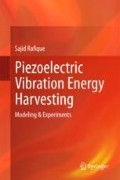Abstract
This chapter presents an experimentally validated distributed parameter model , of a base-excited cantilever bimorph, without any tip mass . Euler–Bernoulli beam theory and the well-known constitutive piezoelectric equation are used to derive the model. The main features of this chapter relative to [1, 2] are illustrated as below:
-
As no tip mass is used in the present study, this is known to be a more stringent validation of the distributed parameter piezoelectric beam model since the presence of a tip mass reduces the influence of the distributed inertia of the beam and restricts effective operation to low frequencies (e.g. 45–50 Hz resonance in) [4]. This study covers the relatively higher resonance frequency range, 120–130 Hz, for which most harvesters are designed for.
-
The graphs showing variation in resonance frequency, resonant voltage amplitude, resonant power and resonant deflection amplitude with respect to change in electrical load are presented. These graphs give a deeper insight into the electromechanical interaction and also provide useful insight into theory and experimental results.
-
Nyquist plots of the FRFs are presented. The Nyquist plots are more descriptive than the usual magnitude graphs. Nyquist plots are used for two purposes here:
-
To determine the mechanical damping.
-
To observe the evolution of the FRFs as the electrical load is changed.
-
-
The measured FRFs are obtained through the application of random excitation, also known as band-limited white noise, rather than a sine sweep [4]. The MatLab code, modelling and simulating the complex equations, of the mathematical model presented in this chapter is attached in Appendix-A of the book.
Access this chapter
Tax calculation will be finalised at checkout
Purchases are for personal use only
References
Erturk, A., & Inman, D. J. (2008). Distributed parameter electromechanical model for cantilevered piezoelectric energy harvesters. Journal of Vibration and Acoustics, 130(4), 041002–041002.
Erturk, A., & Inman, D. J. (2009). An experimentally validated bimorph cantilever model for piezoelectric energy harvesting from base excitations. Smart Materials & Structures, 18(2), 025009–025009.
Roundy, S., Paul, K. W., & Rabaey, J. M. Energy scavenging for wireless sensor networks with special focus on vibrations (1st ed.). USA: Kluwer Academic Publishers.
Rafique, S., & Bonello, P. (2010). Experimental validation of a distributed parameter piezoelectric bimorph cantilever energy harvester. Smart Materials and Structures, 19(9).
DuToit, N., Wardle, L. W., & Kim, S. (2005). Design considerations for MEMS-scale piezoelectric mechanical vibration energy harvesters. Integrated Ferroelectrics, 71, 121–160.
Sodano, H. A., Park, G., & Inman, D. J. (2004). Estimation of electric charge output for piezoelectric energy harvesting. Strain, 40(2), 49–58.
Timoshenko, S., Young, D. H., & Weaver, W. (1974). Vibration problems in engineering. New York: John Wiley and sons Inc.
Inman, D. J. (2008). Engineering vibrations (3rd ed.). Pearson Prentice Hall.
Blevin, R. D. (1984). Formulas for natural frequency and mode shape. Malabar, FL: Robert E. Krieger Publishing Co.
IEEE Standard on Piezoelectricity. (1987). New York.
Bendat, J. S., & Piersol, A. G. (1971). Random data: Analysis and measurement procedures. Wiley Interscience.
Bonello, P., & Groves K. H. (2009). Vibration control using a beam-like adaptive tuned vibration absorber with an actuator-incorporated mass element. Mechanical Engineering Science, 223(7).
Kidner, M. R. F., & Brennan, M. J. (2002). Varying the stiffness of a beam-like neutraliser under fuzzy logic control. Transaction of the ASME, J. Vibration and Acoustics, 124, 90–99.
Ewins, D. J. (2000). Modal testing: Theory, practice, and application (2nd ed.). Baldock: Research Studies Press.
Author information
Authors and Affiliations
Corresponding author
Rights and permissions
Copyright information
© 2018 Springer International Publishing AG
About this chapter
Cite this chapter
Rafique, S. (2018). Distributed Parameter Modelling and Experimental Validation. In: Piezoelectric Vibration Energy Harvesting. Springer, Cham. https://doi.org/10.1007/978-3-319-69442-9_3
Download citation
DOI: https://doi.org/10.1007/978-3-319-69442-9_3
Published:
Publisher Name: Springer, Cham
Print ISBN: 978-3-319-69440-5
Online ISBN: 978-3-319-69442-9
eBook Packages: EnergyEnergy (R0)

